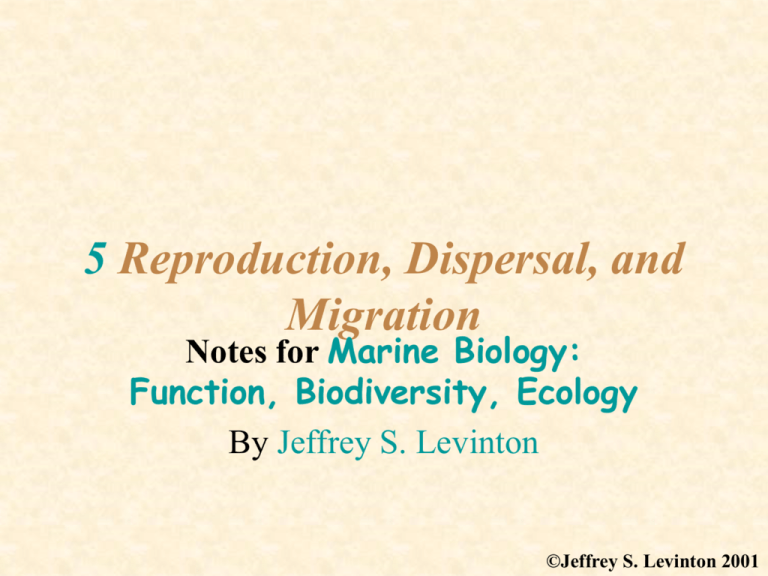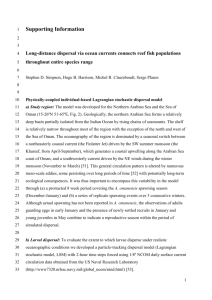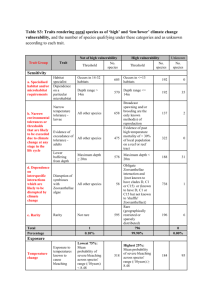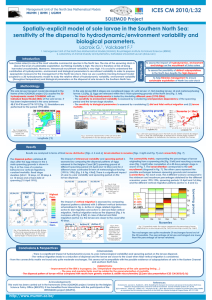Chapter 5
advertisement

5 Reproduction, Dispersal, and Migration Notes for Marine Biology: Function, Biodiversity, Ecology By Jeffrey S. Levinton ©Jeffrey S. Levinton 2001 Sex and Reproduction • IS SEX NECESSARY? • WE MUST SEPARATE SEX AND REPRODUCTION? • SPECIES CAN REPRODUCE WITHOUT SEX (CLONAL GROWTH INVOLVING FISSION OR BUDDING OF INDIVIDUALS) Sex and Reproduction • Non-sexual reproduction: Descendants are genetically identical - clone Colonial species produce a set of individuals that are genetically identical, known as a module; each module may have arisen from a sexually formed zygote Cost of Sex • FEMALE gives up half her possible genes in progeny • Sex involves expenditure of energy and time to find mates, combat among males Benefits of Sex? • genetic diversity - sex increases combinations of genes - resistance against disease • Alternative to sex: clones, must wait for mutations to occur • Sex - recombination produces variable gene combinations, meiosis enhances crossing over of chromosomes: new gene combinations and intragenic variants Sexual Selection • selection for extreme forms that breed more successfully - major claw of fiddler crabs, deer antlers, colors of male birds • Can involve selection for display coloration, enhanced combat structures • Female choice often involved; selection for fit males (good genes hypothesis) Sexual Selection The major claw of fiddler crabs is employed for display to attract females and for combat with other males Types of Sexuality • Separate sexes -gonochoristic • Hermaphroditism -individual can have male or female function Hermaphroditism • Simultaneous • Sequential Protandrous - first male,then female Protogynous - first female then male Sequential Hermaphroditism • Protandry - size advantage model • Eggs costly in terms of resources, so more offspring produced when individual functions as female when large • Male function does not produce great increases in offspring when it gets larger Therefore, there is a threshold size when female function begets more offspring.Smaller individuals do better as males. Number of offspring produced Male at advantage Female at advantage Female Male Body size The size advantage model for Protrandry Protogyny • Male function must result in more offspring when male is older and larger • Important when aggression is important in mating success, e.g., some fishes where males fight to maintain group of female mates Male polymorphism • Males may occur as aggressive fighting morphs, or less aggressive morphs • Found in a number of groups, e.g., some fishes and some amphipod or isopod crustaceans • Determination of morphs can be environmental, genetic • Less aggressive morphs can obtain mates by “sneaky” tactics, which are often successful Factors in Reproductive Success • Percent investment in reproduction reproductive effort • Age of first reproduction (generation time) • Predictability of reproductive success • Juvenile versus adult mortality rate Life History Theory • Tactics that maximize population growth • Evolutionary “tactics”:Variation in reproductive effort, age of reproduction, whether to reproduce more than once • Presume that earlier investment in reproduction reduces resources available to invest in later growth and survival Examples of Life History Tactics • Strong variability in success of reproduction:reproduce more than once • High adult mortality: earlier age of first reproduction,perhaps reproduce only once • Low adult mortality: later age of first reproduction, reproduce more than once Example: Selection in a Fishery • Shrimp Pandalus jordani,protandrous • Danish, Swedish catch (Skagerak) 1930-1956 – stable, increased slowly 1956- 1960 – catch tripled (2000 6300 ton/y) Pandalus jordani fishery Changes in Body Size Period 1949-1950 1954-1957 1961-1962 % over 80 mm Somatic growth change 44% 0 25% 0 14% 0 Changes in Size of Change from Male to Female Period Before 1954 1954 1955-1962 % females < 75 mm long 0 7% (65-74 mm) 14 % (55-74 mm) Sex - factors in fertilization • Planktonic sperm: (and eggs in many cases). Problem of timing, specificity. • Direct sperm transfer: (spermatophores, copulation). Problem of finding mates (e.g., barnacles, timing of reproductive cycle) Planktonic sperm and eggs • Specialized binding/fertilization proteins in sperm and receptors in eggs (bindin in sea urchin sperm, lysin in abalone sperm) • Sperm attractors in eggs • Binding proteins are species-specific, proteins with high rates of evolution Gamete matching important in plankton Timing of sperm and egg release • Epidemic spawning - known in mussels, stimulus of one spawner causes other individuals to shed gametes • Mass spawning - known in coral species, many species spawn on single nights • Timing of spawning (also production of spores by seaweeds) at times of quiet water (slack high or low tide) to maximize fertilization rates Movement of Marine Organisms Dispersal versus migration DISPERSAL: UNDIRECTED MIGRATION: DIRECTED, RETURN SPECIFIC Migration scheme Adult Stock Spawning Area Nursery/Juvenile Feeding Area Migration Types • ANADROMOUS - fish live as adults in salt water, spawn in fresh water (shad, striped bass), more common in higher latitudes • CATADROMOUS - fish live as adults in fresh water, spawn in salt water (eel) more common in lower latitudes • FULLY OCEANIC - herring, green turtle Migration Geographic Specificity of migration - non-specific in some, very specific in others (green turtle, oceanic salmon) Norway Migration of the herring in the North Sea Adult feeding area Spawning areas EEL MIGRATION - adults live in marshes, creeks (European – Anguilla anguilla, American – Anguilla rostrata), migrate to Sargasso Sea, spawn, die, juveniles drift in currents and American eels swim to shore, European eels drift across Atlantic N. America Europe Africa Larval Dispersal Dispersal Types in Benthic Species • PLANKTOTROPHIC DISPERSAL - female produces many (103 - 106) small eggs, larvae feed on plankton, long dispersal time (weeks), some are very long distance (teleplanic) larvae - cross oceans • LECITHOTROPHIC LARVAE - female produces fewer eggs (102 - 103), larger, larvae live on yolk, short dispersal time (hrs-days usually) • DIRECT RELEASE - female lays eggs, or broods young, juveniles released and crawl away Lecithotrophic larva: tadpole larva of the colonial ascidian Botryllus schlosseri Planktotrophic larva of snail Cymatium parthenopetum Pluteus larva of an urchin PROBLEM OF SWIMMING LARVAE: water motion carries them away from appropriate habitats Loss to offshore waters Wind-driven recruitment onshore Self-seeding eddies Longshore drift Shore Population Internal waves, tidal bores Some helping hands in dispersal • Winds that wash larvae to shore • Internal waves - bring material and larvae to shore • Eddies that concentrate larvae in spots • Behavior - in estuaries can allow retention (rise on the flood tide, descend on the ebb tide) Estuarine larval adaptations - retention Larvae rise on the flooding tide, sink to bottom on the ebbing tide: results in retention of larvae within estuary Estuarine larval adaptations - movement of larvae to coastal waters, return of later stage larvae Blue crab, Callinectes sapidus Recruitment of juvenile corals Effect of local eddies on larval retention in a patch reef on the Great Barrier Reef, Australia Planula larva Distance from reef perimeter Newly settled coral Why disperse? • High probability of local extinction; best to export juveniles • Spread your young (siblings) over a variety of habitats; evens out the probability of mortality • Maybe it has nothing to do with dispersal at all; just a feeding ground in the plankton for larvae Settling problems of planktonic larvae • Presettling problems: Starvation Predation in plankton Loss to inappropriate habitats Example of Effect of Starvation: Phytoplankton variation and barnacle larval success Abundant diatoms Number of larvae 1000 500 1950 Normal phytoplankton Early Larval stages Later Larval Stages 0 1951 Failure of phytoplankton Diatom 1000 failure 500 0 March April Semibalanus balanoides settlement in a Scottish Sea Loch Postsettling problems Expectation of life (months) • Energetic cost of metamorphosis • Predation • Crowding --> mortality Initial 6 months 12 months 18 months Interindividual contacts per cm 2 Expectation of life of Semibalanus balanoides as function of crowding Free-swimming larva Selection Behavior Alternating Releasor Random contact Photo+ and Photo- stages With a surface Releasor Selection behaviorcrawling and test surfaces Releasor Releasor Contact w. Contact w. Contact w. Substance on pits and Sfc. Of another adults of grooves same sp. species Block in behavior, contact with inappropriate surface Block in behavior, e.g., contact with crowded surfaces Selection behaviorfrequent turning and flexing ATTACHMENT Stages in the selection of substratum by planktonic larvae The End









